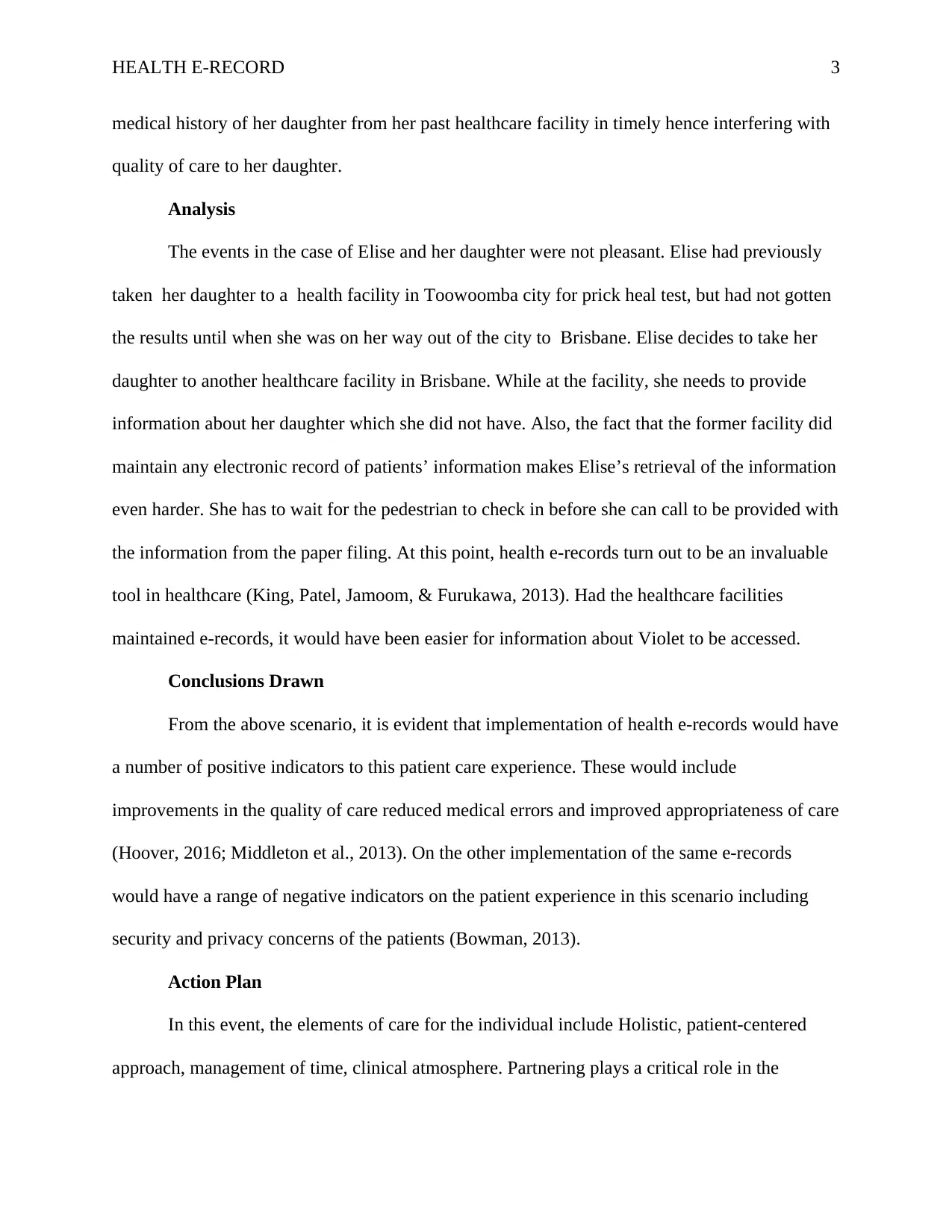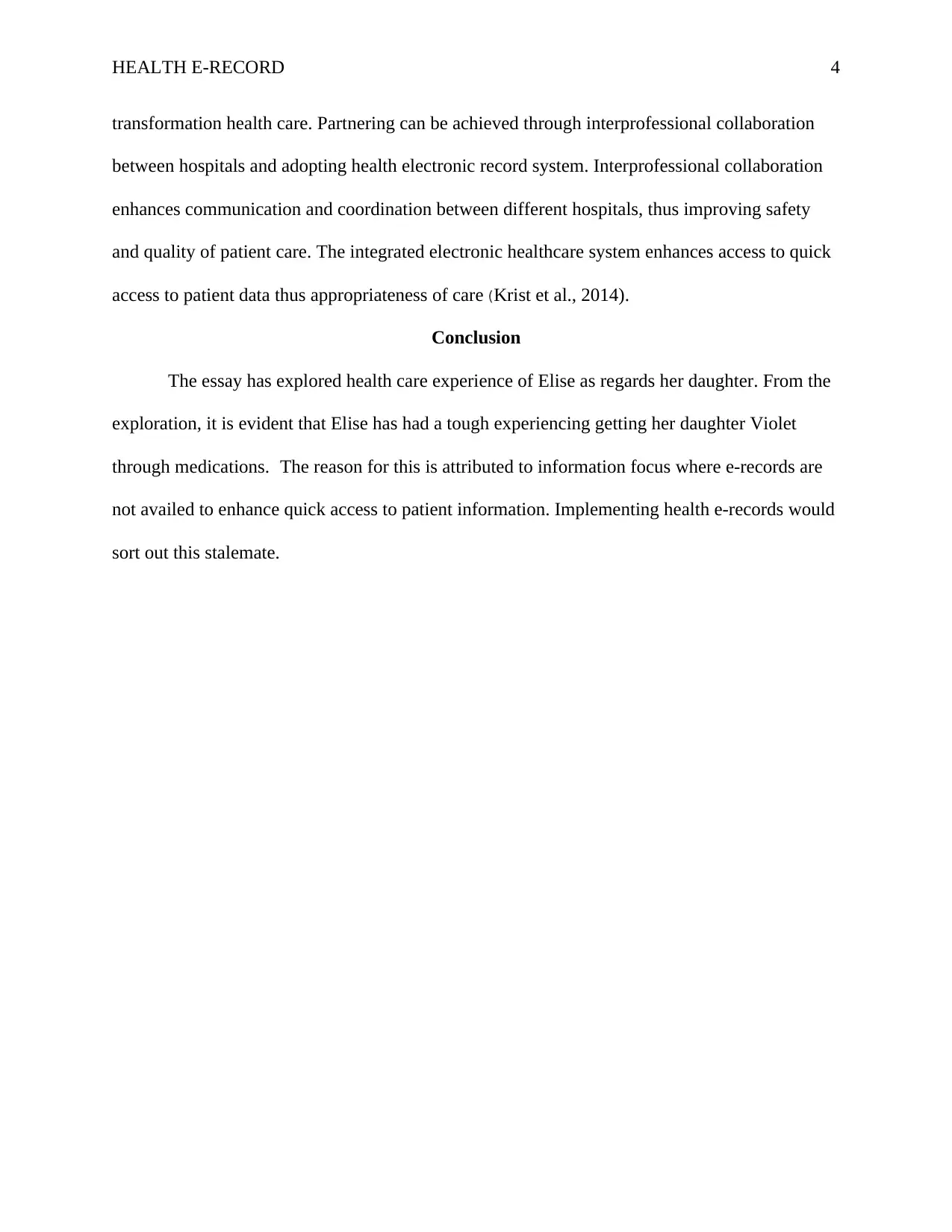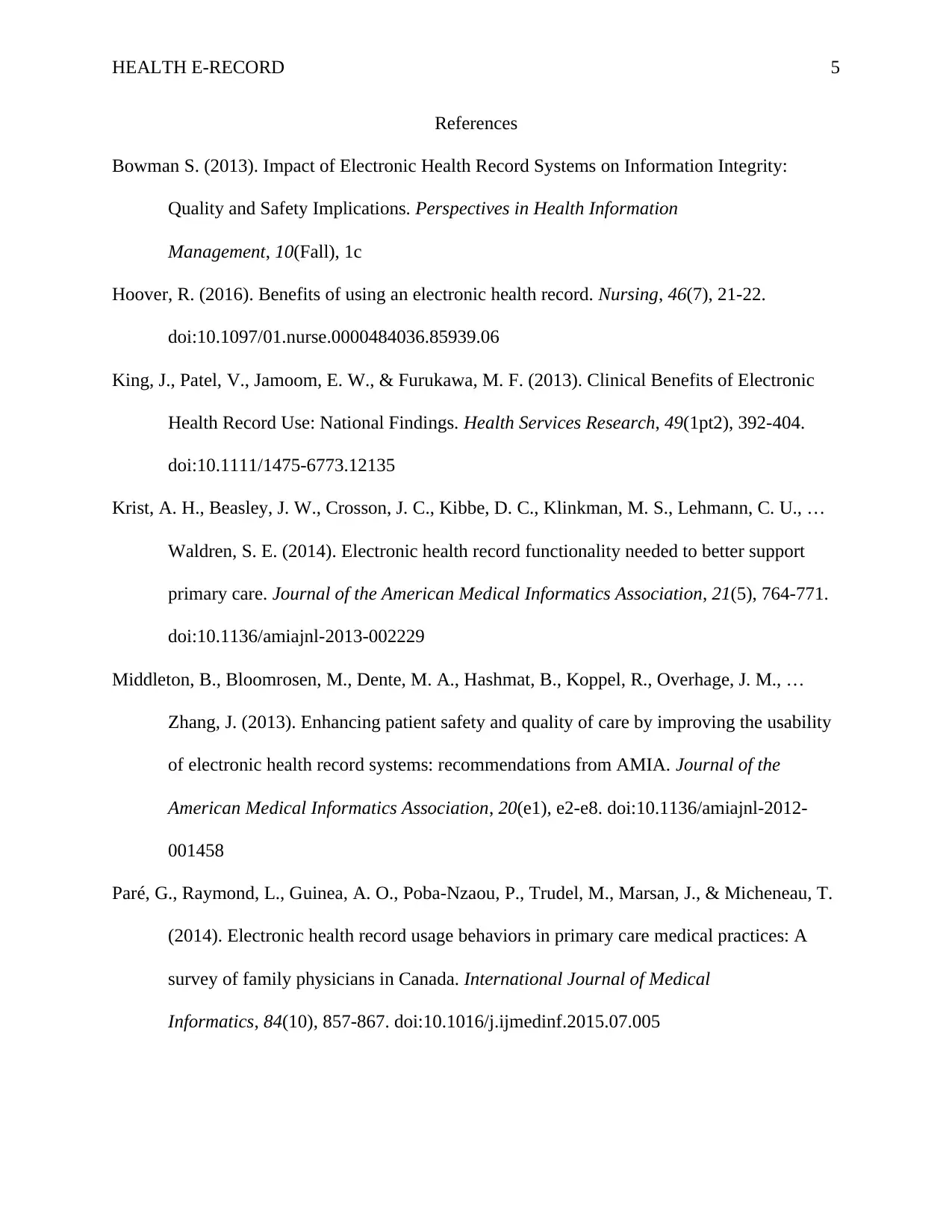Health E-Record: Enhancing Healthcare with Technology
VerifiedAdded on 2020/03/16
|5
|1082
|207
Essay
AI Summary
This essay analyzes the impact of health e-records on patient care, using a case study of a mother's experience with her daughter's medical needs. The essay highlights the challenges of accessing patient information in a timely manner when electronic records are not available. It discusses the benefits of implementing health e-records, such as improved quality of care, reduced medical errors, and enhanced appropriateness of care. The essay also acknowledges potential negative impacts like security and privacy concerns. Furthermore, it suggests an action plan that emphasizes holistic, patient-centered approaches, efficient time management, and interprofessional collaboration. The conclusion underscores the importance of health e-records in resolving issues related to information access and improving overall healthcare experiences. The essay references several studies to support its claims.

Running head: HEALTH E-RECORD 1
Health e-record
(Student’s Name)
(Institutional Affiliations)
Health e-record
(Student’s Name)
(Institutional Affiliations)
Paraphrase This Document
Need a fresh take? Get an instant paraphrase of this document with our AI Paraphraser

HEALTH E-RECORD 2
Health e-record
Introduction
Health e-record refers encompasses a nationwide system integrating data from healthcare
facilities all over to generate a common record all patients can access online (Paré et al., 2014).
This paper reflects on the hustles of Elise with regards to her daughter’s medication focusing on
the usefulness of health e-record. While Elise was able to have a successful medical procedure
for Violet, the presence of e-record would have handy.
Description
Elise receives an emergency call from her paediatrician regarding the prick test of her
baby, but could not visit the facility as she was out of town travelling to another city, Brisbane.
In this event, one notes two key themes of nursing care; Information focus and patient focus.
Information focus relates to how information is used and made accessible to the patient while
patient focus relates to how the care services is based on the patient’s needs.
Feelings
As a nurse, I feel remorseful that it took Elise through a lot of hustle before she could get
her daughter, Violet through her medical procedures. All these glitches were caused by the
information focus of nursing care. Elise could not get information regarding the past medical
history of her daughter from her former healthcare facility in time when she moved between
cities.
Values/Beliefs
As a nurse, I have beliefs that patients are entitled to access good quality care with less
hustles. The quality of service a patient receives depends upon the timeliness and the relevance
of care to the needs of the patients. In this case, Elise could not access the information about the
Health e-record
Introduction
Health e-record refers encompasses a nationwide system integrating data from healthcare
facilities all over to generate a common record all patients can access online (Paré et al., 2014).
This paper reflects on the hustles of Elise with regards to her daughter’s medication focusing on
the usefulness of health e-record. While Elise was able to have a successful medical procedure
for Violet, the presence of e-record would have handy.
Description
Elise receives an emergency call from her paediatrician regarding the prick test of her
baby, but could not visit the facility as she was out of town travelling to another city, Brisbane.
In this event, one notes two key themes of nursing care; Information focus and patient focus.
Information focus relates to how information is used and made accessible to the patient while
patient focus relates to how the care services is based on the patient’s needs.
Feelings
As a nurse, I feel remorseful that it took Elise through a lot of hustle before she could get
her daughter, Violet through her medical procedures. All these glitches were caused by the
information focus of nursing care. Elise could not get information regarding the past medical
history of her daughter from her former healthcare facility in time when she moved between
cities.
Values/Beliefs
As a nurse, I have beliefs that patients are entitled to access good quality care with less
hustles. The quality of service a patient receives depends upon the timeliness and the relevance
of care to the needs of the patients. In this case, Elise could not access the information about the

HEALTH E-RECORD 3
medical history of her daughter from her past healthcare facility in timely hence interfering with
quality of care to her daughter.
Analysis
The events in the case of Elise and her daughter were not pleasant. Elise had previously
taken her daughter to a health facility in Toowoomba city for prick heal test, but had not gotten
the results until when she was on her way out of the city to Brisbane. Elise decides to take her
daughter to another healthcare facility in Brisbane. While at the facility, she needs to provide
information about her daughter which she did not have. Also, the fact that the former facility did
maintain any electronic record of patients’ information makes Elise’s retrieval of the information
even harder. She has to wait for the pedestrian to check in before she can call to be provided with
the information from the paper filing. At this point, health e-records turn out to be an invaluable
tool in healthcare (King, Patel, Jamoom, & Furukawa, 2013). Had the healthcare facilities
maintained e-records, it would have been easier for information about Violet to be accessed.
Conclusions Drawn
From the above scenario, it is evident that implementation of health e-records would have
a number of positive indicators to this patient care experience. These would include
improvements in the quality of care reduced medical errors and improved appropriateness of care
(Hoover, 2016; Middleton et al., 2013). On the other implementation of the same e-records
would have a range of negative indicators on the patient experience in this scenario including
security and privacy concerns of the patients (Bowman, 2013).
Action Plan
In this event, the elements of care for the individual include Holistic, patient-centered
approach, management of time, clinical atmosphere. Partnering plays a critical role in the
medical history of her daughter from her past healthcare facility in timely hence interfering with
quality of care to her daughter.
Analysis
The events in the case of Elise and her daughter were not pleasant. Elise had previously
taken her daughter to a health facility in Toowoomba city for prick heal test, but had not gotten
the results until when she was on her way out of the city to Brisbane. Elise decides to take her
daughter to another healthcare facility in Brisbane. While at the facility, she needs to provide
information about her daughter which she did not have. Also, the fact that the former facility did
maintain any electronic record of patients’ information makes Elise’s retrieval of the information
even harder. She has to wait for the pedestrian to check in before she can call to be provided with
the information from the paper filing. At this point, health e-records turn out to be an invaluable
tool in healthcare (King, Patel, Jamoom, & Furukawa, 2013). Had the healthcare facilities
maintained e-records, it would have been easier for information about Violet to be accessed.
Conclusions Drawn
From the above scenario, it is evident that implementation of health e-records would have
a number of positive indicators to this patient care experience. These would include
improvements in the quality of care reduced medical errors and improved appropriateness of care
(Hoover, 2016; Middleton et al., 2013). On the other implementation of the same e-records
would have a range of negative indicators on the patient experience in this scenario including
security and privacy concerns of the patients (Bowman, 2013).
Action Plan
In this event, the elements of care for the individual include Holistic, patient-centered
approach, management of time, clinical atmosphere. Partnering plays a critical role in the
⊘ This is a preview!⊘
Do you want full access?
Subscribe today to unlock all pages.

Trusted by 1+ million students worldwide

HEALTH E-RECORD 4
transformation health care. Partnering can be achieved through interprofessional collaboration
between hospitals and adopting health electronic record system. Interprofessional collaboration
enhances communication and coordination between different hospitals, thus improving safety
and quality of patient care. The integrated electronic healthcare system enhances access to quick
access to patient data thus appropriateness of care (Krist et al., 2014).
Conclusion
The essay has explored health care experience of Elise as regards her daughter. From the
exploration, it is evident that Elise has had a tough experiencing getting her daughter Violet
through medications. The reason for this is attributed to information focus where e-records are
not availed to enhance quick access to patient information. Implementing health e-records would
sort out this stalemate.
transformation health care. Partnering can be achieved through interprofessional collaboration
between hospitals and adopting health electronic record system. Interprofessional collaboration
enhances communication and coordination between different hospitals, thus improving safety
and quality of patient care. The integrated electronic healthcare system enhances access to quick
access to patient data thus appropriateness of care (Krist et al., 2014).
Conclusion
The essay has explored health care experience of Elise as regards her daughter. From the
exploration, it is evident that Elise has had a tough experiencing getting her daughter Violet
through medications. The reason for this is attributed to information focus where e-records are
not availed to enhance quick access to patient information. Implementing health e-records would
sort out this stalemate.
Paraphrase This Document
Need a fresh take? Get an instant paraphrase of this document with our AI Paraphraser

HEALTH E-RECORD 5
References
Bowman S. (2013). Impact of Electronic Health Record Systems on Information Integrity:
Quality and Safety Implications. Perspectives in Health Information
Management, 10(Fall), 1c
Hoover, R. (2016). Benefits of using an electronic health record. Nursing, 46(7), 21-22.
doi:10.1097/01.nurse.0000484036.85939.06
King, J., Patel, V., Jamoom, E. W., & Furukawa, M. F. (2013). Clinical Benefits of Electronic
Health Record Use: National Findings. Health Services Research, 49(1pt2), 392-404.
doi:10.1111/1475-6773.12135
Krist, A. H., Beasley, J. W., Crosson, J. C., Kibbe, D. C., Klinkman, M. S., Lehmann, C. U., …
Waldren, S. E. (2014). Electronic health record functionality needed to better support
primary care. Journal of the American Medical Informatics Association, 21(5), 764-771.
doi:10.1136/amiajnl-2013-002229
Middleton, B., Bloomrosen, M., Dente, M. A., Hashmat, B., Koppel, R., Overhage, J. M., …
Zhang, J. (2013). Enhancing patient safety and quality of care by improving the usability
of electronic health record systems: recommendations from AMIA. Journal of the
American Medical Informatics Association, 20(e1), e2-e8. doi:10.1136/amiajnl-2012-
001458
Paré, G., Raymond, L., Guinea, A. O., Poba-Nzaou, P., Trudel, M., Marsan, J., & Micheneau, T.
(2014). Electronic health record usage behaviors in primary care medical practices: A
survey of family physicians in Canada. International Journal of Medical
Informatics, 84(10), 857-867. doi:10.1016/j.ijmedinf.2015.07.005
References
Bowman S. (2013). Impact of Electronic Health Record Systems on Information Integrity:
Quality and Safety Implications. Perspectives in Health Information
Management, 10(Fall), 1c
Hoover, R. (2016). Benefits of using an electronic health record. Nursing, 46(7), 21-22.
doi:10.1097/01.nurse.0000484036.85939.06
King, J., Patel, V., Jamoom, E. W., & Furukawa, M. F. (2013). Clinical Benefits of Electronic
Health Record Use: National Findings. Health Services Research, 49(1pt2), 392-404.
doi:10.1111/1475-6773.12135
Krist, A. H., Beasley, J. W., Crosson, J. C., Kibbe, D. C., Klinkman, M. S., Lehmann, C. U., …
Waldren, S. E. (2014). Electronic health record functionality needed to better support
primary care. Journal of the American Medical Informatics Association, 21(5), 764-771.
doi:10.1136/amiajnl-2013-002229
Middleton, B., Bloomrosen, M., Dente, M. A., Hashmat, B., Koppel, R., Overhage, J. M., …
Zhang, J. (2013). Enhancing patient safety and quality of care by improving the usability
of electronic health record systems: recommendations from AMIA. Journal of the
American Medical Informatics Association, 20(e1), e2-e8. doi:10.1136/amiajnl-2012-
001458
Paré, G., Raymond, L., Guinea, A. O., Poba-Nzaou, P., Trudel, M., Marsan, J., & Micheneau, T.
(2014). Electronic health record usage behaviors in primary care medical practices: A
survey of family physicians in Canada. International Journal of Medical
Informatics, 84(10), 857-867. doi:10.1016/j.ijmedinf.2015.07.005
1 out of 5
Related Documents
Your All-in-One AI-Powered Toolkit for Academic Success.
+13062052269
info@desklib.com
Available 24*7 on WhatsApp / Email
![[object Object]](/_next/static/media/star-bottom.7253800d.svg)
Unlock your academic potential
Copyright © 2020–2025 A2Z Services. All Rights Reserved. Developed and managed by ZUCOL.





